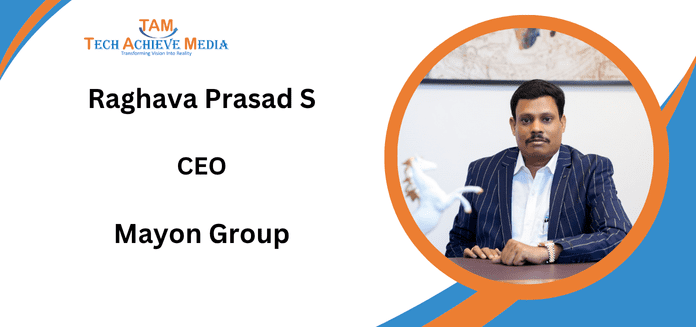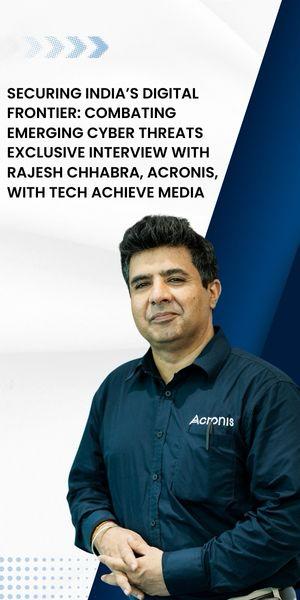With over a million square feet of IT and office space completed, Mayon Group has steadily built a reputation for integrated delivery and executional precision. Central to this success is a simple but powerful philosophy, which is unified accountability across disciplines. In conversation with Tech Achieve Media, Raghava Prasad S, CEO of Mayon Group, discusses how this model has enabled consistency in quality and timelines, how technology is transforming construction methodologies, and why collaboration and transparency are key to building resilient, future-ready commercial spaces
TAM: Mayon Group has completed over a million square feet of IT and office space. What core philosophy has driven this consistent excellence in design and delivery?
Raghava Prasad S: My journey began on construction sites as an electrical supervisor, working hands-on with installation teams. That ground-level experience revealed something critical: the pressing need for unified responsibility. Projects of all sizes routinely faced delays and quality inconsistencies due to fragmented accountability from multiple vendors, leading to dissatisfied clients.
Also read: Why Warehousing has Witnessed an Uptick in India
I realized this could be addressed, and it was a systemic opportunity. The insight led to Mayon. Our foundational philosophy is simple: one organization, complete accountability. We own electrical infrastructure, civil construction, interiors, and turnkey delivery. When all disciplines operate under unified leadership, there’s nowhere to hide. That we have completed over a million square feet of premium commercial space achievement stems directly from this integrated model.
But beyond the metrics, I’ve come to understand something deeper: quality, consistency, and accountability transcend corporate rhetoric. They’re embedded in our DNA. When every team member recognizes the company’s reputation is on the line with every project, excellence stops being aspirational, it becomes inevitable.
TAM: How is Mayon integrating innovation and technology into its architectural and construction processes to stay ahead in a rapidly evolving market?
Raghava Prasad S: Technology investment alone doesn’t differentiate anyone anymore. We’ve adopted 3D modelling, real-time project tracking, and automated MEP systems, but what truly separates us is how we deploy these tools. Most companies treat technology as infrastructure. We treat it as a cultural enabler.
Our competitive advantage lies in breaking organizational silos. When design, civil, and services teams operate within a unified coordination platform, inefficiencies surface during planning, not during costly on-site rework. We catch conflicts months before excavation begins. We’re also trialling prefabricated systems, modular construction, and advanced IoT monitoring, technologies that compress timelines and improve consistency.
But here’s where we genuinely stay ahead: our site teams drive continuous innovation. Our managers and leadership spend significant time on site, listening to supervisors and workers who operate at ground zero. They identify inefficiencies invisible from corporate offices. This bidirectional learning, technology enabling better decisions, field teams refining methodology, creates a compounding advantage. We’re not just implementing smart systems; we’re building an organization that learns faster and adapts quicker than competitors. That’s how you maintain market leadership in a rapidly evolving industry.
TAM: In an industry where timelines and quality often conflict, how does your team balance precision engineering with customer satisfaction?
Raghava Prasad S: This is where I think we may have genuinely cracked the code. You can’t compromise on either dimension, and frankly, they’re not in conflict if you architect execution properly. We run rigorous quality checks at every phase, conduct regular audits, and execute comprehensive post-installation reviews. When issues surface, we diagnose root cause, not just apply surface solutions.
On execution, we deploy shift-based operations, parallel work tracks, and intensive daily coordination. I recall a global financial services client requiring occupancy in four months, a timeline most would consider reckless. We restructured everything, coordinated simultaneously across civil, services, and interiors, maintained safety as absolute, and delivered ahead of schedule.
The critical differentiator: transparency. Our clients access real-time visibility; financial status, technical progress, and emerging challenges. This isn’t about looking good; it’s operationally powerful. When clients understand issues immediately rather than discovering them later, they become collaborative problem-solvers, not adversarial enforcers. They prioritize decisions quickly. They adjust scopes efficiently. They trust our judgment on trade-offs. That trust accelerates everything. Early delivery doesn’t come from cutting corners; it comes from clients and contractors moving in genuine alignment. Transparency eliminates friction, leading to speed.
TAM: What emerging trends in workplace or IT infrastructure design do you believe will redefine commercial spaces in the next five years?
Raghava Prasad S: Five things are reshaping how we think about commercial spaces. First, modular and prefabricated construction, this isn’t a fad, it’s fundamental. You get speed, consistency, and less waste. Second, occupant wellness. Air quality, natural light, ergonomic design, organizations realize healthy spaces drive productivity. That’s baseline now, not luxury.
Third, smart systems are essential. Real-time energy management, IoT sensors, automated controls, buildings need to be intelligent. Fourth, customization matters enormously. Companies want spaces reflecting their identity and values, not cookie-cutter designs. Finally, sustainability is non-negotiable. Clients care deeply about carbon footprint, water usage, and waste management. The organizations thriving in five years will be those treating these not as add-ons, but as core to how they design and build.
TAM: Looking ahead, what is your strategic vision for Mayon Group’s growth, both in terms of market expansion and design innovation?
Raghava Prasad S: My ambition for Mayon is what I call “scale with soul.” We’re not chasing growth metrics blindly; we’re expanding thoughtfully. Right now, we’re exploring energy infrastructure, smart buildings, high-tech facilities, and data centre projects. The broader Mayon Group already has successful IT services and control panels divisions, we’re exploring where our engineering expertise can create true impact.
What excites me most is becoming an industry benchmark for quality, sustainability, and design innovation. We want a reputation that says, “Mayon delivers spaces that outperform expectations.” We’re investing in our teams constantly – better training, embracing new technologies, staying grounded in sustainable practices. Honestly, I’m most proud of our people. They’re talented, committed professionals functioning as a unified entity. That’s rare.
On the design innovation front, I want Mayon to pioneer the next generation of architectural and construction thinking. This means spaces that adapt to future workplace demands proactively or as they arise, structures that minimize environmental impact without compromising performance, and buildings that enhance how people work and collaborate. We’re investing in research, trialling emerging methodologies, and pushing boundaries on what sustainable, intelligent infrastructure can achieve. That’s the legacy we are building. It’s a journey, and we are deeply committed to it.









